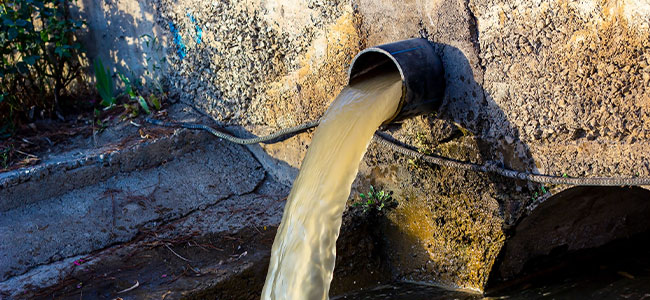
Addressing Water Contamination Issues in Industrial Workplaces
While water contamination is quite common, industrial companies can address contamination issues to maximize water systems and improve workplace safety.
- By Mia Barnes
- Mar 20, 2024
While fresh water is a precious and essential resource, contamination is quite common. Many accidental exposures — both by drinking or touching chemical water — have resulted in diseases. Learn how industrial companies can address contamination issues to maximize water systems and improve workplace safety.
Prevalence of Water Contamination in Industrial Workplaces
Scientists in the U.S. conducted a study to determine what contaminants of emerging concern (CECs) are present in treated and untreated water using samples from 25 treatment plants throughout the country. They determined 247 microbiological pollutants, including chemicals used in homes, businesses and industries. Unfortunately, some of these aren't monitored or regulated by the EPA. Therefore, information about them is scarce, posing a problem in the case of contamination.
Sources of Water Contamination in Industrial Settings
Pollutants can seep into the water systems from many sources.
- Chemical spills. Industrial businesses use several agents and solvents in their processes. Leaks can sometimes occur due to accidents or negligence.
- Microbial contamination. It can happen in industrial plants where biofilms and stagnant water exist. These environments can become breeding grounds for microorganisms for water pollutants.
- Heavy metals. In the U.S., roughly 9.2 million service lines are made of lead, carrying water in several communities. Poisoning can happen when passing water corrodes the metal and distributes traces to households and workplaces.
Health Impacts of Contamination on Industrial Workers
Water pollution can affect anyone. Contamination often leads to the following health concerns.
Respiratory Issues
Vanadium, molybdenum and sulfate abundant in municipal water lines are associated with an elevated risk of nontuberculous mycobacteria pulmonary infections in individuals with cystic fibrosis.
Skin Diseases
Industrial workers handle all sorts of chemicals, making them more susceptible to various skin diseases that range from itching and rash to cancer. Melanosis and keratosis were the most reported complications of people exposed to excessive arsenic in drinking water.
Gastrointestinal Problems
A CDC study found 17 pathogens linked with waterborne infectious diseases in three water categories: recreational, drinking and nonrecreational nondrinking. Norovirus infection or stomach flu — characterized by vomiting and diarrhea — was the leading health concern associated with drinking water.
Best Practices to Address Water Contamination
Clean drinking and sanitation water are crucial to maintaining overall safety in the workplace. Here are some tips to address water line issues.
1. Regular Water Testing and Monitoring
Frequent testing and monitoring are necessary to ensure safe water quality in industrial environments. Several options for testing kits are available in the market. Just collect drinking or wastewater samples and follow the instructions to assess the chemistry.
These solutions are often accurate, but discrepancies can occur because of interference, like handler mistakes. Roughly 80 percent to 85 percent are due to the user, but it’s avoidable. Make sure to use clean equipment before and after testing, collect accurate samples and employ appropriate testing methods to obtain precise analysis.
2. Proper Containment Measures
Even if an existing water system is made of steel pipes, it may have lead-based solder to join the parts. Lead is harmful to health and seeps into potable water through corrosion.
The best solution is to replace plumbing materials with lead-free options, like PVC pipes. However, replacing the infrastructure can be expensive. That’s why the EPA implemented the Lead and Copper Rule (LCR). The goal is for residential, school, commercial and industrial systems to control lead and copper contamination in water lines to mitigate health issues.
Concentrations for lead and copper should not exceed action levels of 15 parts per billion (ppb) and 1.3 parts per million (ppm) in over 10 percent of samples, respectively. The business or utility system must perform additional countermeasures to lower corrosion if levels exceed the allowed benchmarks.
Additionally, organizations that produce wastewater as a byproduct are often required to have a treatment system. There are several strategies to do this, depending on the contaminants.
- Solids. These can be removed through sedimentation, case filtration or ultrafiltration.
- Oils and grease. Oil skimmers can separate both liquids for proper disposal.
- Biodegradable organics. These can be treated through activated sludge or trickling filter.
- Other organics. Advanced oxidation processing, distillation and adsorption can treat paints, pesticides and solvents.
- Acids and alkalis. These can be neutralized in controlled conditions.
3. Use of Personal Protective Equipment (PPE)
Employees who handle or are exposed to chemical contaminants when using water must always wear the recommended safety suits to minimize the hazard. These tools include gloves, safety glasses and shoes, respirators, ear plugs or muffs, and coveralls or full-body suits.
4. Maintain the Best Practices
Industrial employers are required to provide clean, safe drinking water to workers. Therefore, the safety managers are responsible for ensuring water quality is maintained in all systems by following OSHA guidelines.
For example, containers used to manage liquid waste must be thoroughly cleaned and in the best sanitary condition. They should be promptly and properly disposed of. Nonpotable water for industrial purposes must be marked, indicating it's not intended for drinking and washing.
Following these guidelines can provide a better structure for use and sanitation within the workplace, making it easier for safety professionals to detect water conditions and abnormalities.
Testing and Monitoring Can Mitigate Health Risks
Organizations must have an established system to track water quality in the workplace, both potable and non-potable. It limits the health risks associated with pollutants. Safety managers must promptly inform the employees if contamination occurs and find ways to address the problem through various treatment methods.